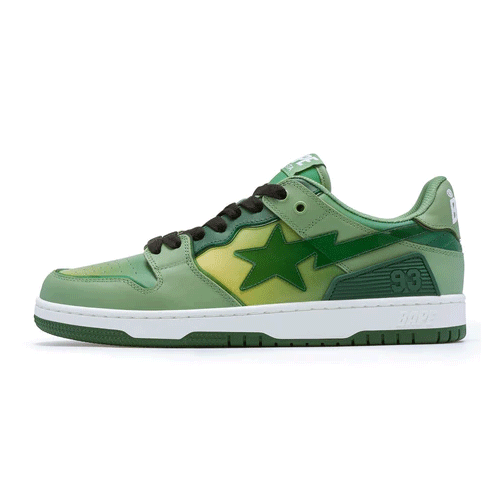Bapesta: The Iconic Sneaker That Redefined Streetwear

In the world of streetwear, few sneakers command attention quite like the Bapesta. Recognizable by its bold design and unmistakable star logo, the Bapesta has become a symbol of rebellion, creativity, and cross-cultural fashion. Born from the legendary Japanese brand A Bathing Ape (BAPE), this sneaker isn’t just footwear—it’s a cultural statement.
Whether you're a long-time collector or new to sneaker culture, understanding the legacy of the Bapesta means diving into the heart of street fashion's evolution. This article explores the history, design, influence, and resurgence of the Bapesta in today’s ever-changing fashion landscape.
The Origins of the Bapesta
The Bapesta was first introduced in the early 2000s by Nigo, the founder of A Bathing Ape. At the time, BAPE had already established itself as a powerhouse in the Tokyo streetwear scene, known for its bold graphics, camouflage prints, and exclusivity. But Nigo had his eyes set on something bigger: creating a sneaker that could rival the dominance of American footwear giants.
Inspired by the Nike Air Force 1, the Bapesta took its silhouette and gave it a distinctly Japanese twist. The star-shaped logo, known as the "STA", replaced Nike’s Swoosh, while bright colorways, patent leather finishes, and playful designs made the sneaker stand out instantly.
It was a sneaker that wore its influence openly but added a completely new attitude. In Japan, it became an instant hit. Internationally, it became a cult favorite.
Breaking Boundaries: Bapesta Goes Global
The 2000s saw streetwear begin to transcend borders, and the Bapesta was right at the center of this movement. What helped propel the sneaker globally was its strategic use of celebrity endorsements.
Nigo’s close relationships with artists like Pharrell Williams, Kanye West, and Lil Wayne played a pivotal role. These collaborations weren’t just marketing gimmicks—they were moments that fused music, fashion, and art. When Kanye donned a pair of Bapestas in his College Dropout era, or when Pharrell was seen rocking them with a BBC Ice Cream hoodie, the message was clear: the Bapesta was not just for Tokyo—it was for the world.
As hip-hop culture became more intertwined with fashion, the Bapesta found its place on stages, red carpets, and in countless music videos. It became a symbol of creative individuality and luxury in the streetwear space.
Design Elements That Make the Bapesta Stand Out
What makes the Bapesta so iconic isn’t just its shape, but the way it’s used as a canvas. While the Air Force 1 often leaned on minimalism and subtle color blocking, the Bapesta went in the opposite direction: vibrant, loud, and unafraid.
Patent leather became a signature material. Whether it was candy-colored reds, metallic silvers, or camouflage patterns, every Bapesta screamed attention. The "STA" logo added a sense of motion and energy, while the tongue and heel branding subtly nodded to its BAPE heritage.
Collaborations and limited drops added to the mystique. From Marvel Comics to SpongeBob SquarePants, Bapestas became collectible art pieces as much as wearable shoes. And because they were often released in limited quantities, scarcity drove up demand.
Cultural Impact and Streetwear Legacy
The Bapesta's cultural significance goes beyond aesthetics. It challenged the idea of authenticity in sneaker culture. At a time when mimicry was often frowned upon, Nigo redefined it as homage and reinterpretation. He didn’t hide the Air Force 1 influence—he celebrated it and infused it with Japanese creativity and design philosophy.
This approach influenced a wave of other streetwear brands. Suddenly, reinterpretation was in vogue. Brands began to collaborate more openly, and the idea of remixing Western styles through Eastern perspectives became a norm rather than an exception.
The Bapesta also paved the way for luxury streetwear, a concept that’s become mainstream today. With its high price point, limited availability, and fashion-forward aesthetic, the Bapesta was one of the first sneakers to merge hype and high fashion successfully.
Bapesta in the Modern Sneaker Scene
After a brief period of reduced visibility, Bapesta made a strong comeback in the late 2010s and early 2020s. The resurgence of Y2K fashion trends, combined with a renewed interest in archive streetwear, brought Bapesta back into the spotlight.
New collaborations with artists like Kid Cudi, Skepta, and Jaden Smith brought fresh energy to the sneaker. The brand also began experimenting with new materials and silhouettes, subtly updating the classic shape for a new generation while retaining its original spirit.
Today, Bapesta sits comfortably next to legacy models like the Jordan 1, Nike SB Dunk, and Adidas Superstar in any serious sneakerhead’s rotation. Its unique blend of nostalgia and novelty makes it a versatile and desirable piece for both new fans and longtime collectors.
Styling the Bapesta: Fashion Tips
Wearing a pair of Bapestas is about making a statement. Because of their bold design and bright colorways, they often serve as the focal point of an outfit.
Pairing them with neutral tones like black cargos, vintage denim, or a classic hoodie can let the shoes shine. For those who prefer a bolder look, matching Bapestas with graphic tees, varsity jackets, or oversized outerwear taps directly into early-2000s streetwear nostalgia.
They also work well in modern fashion fits, especially in layered street style. Cropped pants that show off the ankle, or wide-leg silhouettes, help draw attention to the sneaker’s chunky profile.
The Future of Bapesta
As BAPE continues to expand its global presence, the Bapesta remains one of its flagship products. Limited releases, artist collaborations, and a savvy understanding of sneaker trends suggest that this silhouette isn’t going anywhere.
In a time when sneaker culture is constantly evolving—with trends shifting from minimalism to maximalism and back—the Bapesta maintains a timeless appeal. It’s not just about hype; it’s about heritage.
With a younger generation looking to the past for style inspiration, and older fans appreciating its cultural roots, the Bapesta is perfectly poised to remain relevant for years to come.
Final Thoughts
The Bapesta is more than just a sneaker—it’s a symbol of innovation, cultural fusion, and streetwear’s evolution. From Tokyo’s backstreets to global fashion runways, its journey reflects the ever-changing landscape of fashion and the power of bold design.
For any sneaker enthusiast or fashion lover, understanding the legacy of the Bapesta isn’t just about knowing its history—it’s about appreciating how one shoe can capture the spirit of a generation.






